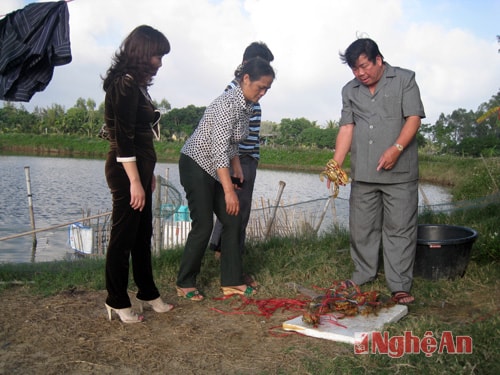Diversifying saltwater and brackishwater aquaculture: New direction in aquaculture
(Baonghean) - After the somewhat fortunate successes of the "monoculture" farming model, recently farmed shrimp have always faced risks due to diseases. Since the beginning of 2013, farmers in some districts of our province have changed their investment direction and diversified their farming objects; the results have brought success in both output and income value.
Together with the staff of the Department of Agriculture and Rural Development, Nghi Loc District Agricultural Extension Station, we visited the aquaculture model of Mr. Le Anh Tuan in Hamlet 1, Nghi Hop Commune. Surprisingly, while many people here still use white-leg shrimp as the main farming object, in recent years Mr. Tuan has chosen his own direction, which is to invest in commercial crab farming. When we arrived, he was diligently digging the soil to build banks, pumping water, checking salinity, and monitoring the growth and development of crabs. He confided: “For many years, I have been very aware of the “gains and losses” from raising giant tiger prawns, white-leg shrimp, to raising fish fry, so I decided to switch to commercial crab farming. Crabs have the advantage of a short rearing time of 60 to 90 days for harvest (depending on the size of the crab fry), low risk, and basically the source of natural crab fry and crab feed is available locally. However, the difficulty is the large investment capital, farmers must have a firm grasp of the techniques, perform well the steps of pond renovation and disease prevention.”
 |
| Officials from the Provincial Agricultural Extension Center inspected Mr. Tuan's crab farming model in Hamlet 1, Nghi Hop Commune, Nghi Loc. |
Mr. Tuan said: The family just bought 3 more ponds with an area of 0.5 ha/pond. In previous years, the family raised 2 crops but most of them failed, at least 10 to 20 million VND. In early 2013, he invested nearly 300 million VND in bass fry and nearly 200 million VND in red-bellied fish fry. After 2 weeks of raising, they got sick and died, and all their wealth was gone. Now, with support in farming techniques and a part of the fry and feed from the provincial and district agricultural extension centers, the couple decided to borrow capital to invest in renovating the crab pond. As a result, on an area of 0.5 ha of pond, they released 5,000 crab fry, the average size of the fry was 40 crabs/kg, the crab feed was mainly trash fish. After nearly 3 months of raising, the crabs reached an average size of 0.3 kg/crab, productivity reached 1.86 tons/ha, average selling price 270,000 VND/kg, he earned 502 million VND. After deducting expenses (seeds, food, 3 months of care), the net profit was 400 million VND. Compared to the mass, productivity increased by 23%, economic efficiency increased by 25%.
Not only Mr. Tuan, this year, Mrs. Dinh Thi Tan's family in Hung Hoa commune, Vinh city, with an area of 5,000 m2 of pond, crab productivity reached 1.95 tons/ha, earned 243.7 million VND. After deducting expenses (seeds, food, 3 months of care), Mrs. Tan had a net profit of 198 million VND. Many brackish water aquaculture households, in addition to choosing crabs as the farming object, have expanded the farming of sea bass, grouper, cobia, red snapper... to increase income and reduce risks. From the success of these two models, up to now, the two localities of Nghi Loc and Vinh city have developed the crab farming area to over 25 hectares, something that was very rare in previous years.
Talking to some people, we found that in the first crop of 2013, Nghe An's aquatic products encountered many difficulties due to the unusual weather changes, the white-leg shrimp breed did not meet the seasonal needs of farmers, the shrimp disease was quite complicated, the shrimp died of unknown causes, so many shrimp farming households were struggling because of debt. The models of raising crabs, clams, sea bass, grouper, cobia and yellow-finned white pomfret, pink-finned red pomfret... are suitable choices, helping farmers recover some of their failures. According to the calculations of some households, raising sea bass, yellow-finned white pomfret, and crabs can bring in a profit of 150 to 200 million VND/ha, which is quite certain. On the other hand, the rotation of many farming objects on the same area helps improve the pond environment better so that the next crop can raise white-leg shrimp again.
However, to develop the farming of these species sustainably, the province needs to have a specific plan for the farming area, proactively providing both quantity and quality of breeds because the current prices of these species are too high. On the other hand, based on existing policies, the province also needs to consider balancing additional support funds, building many demonstration models in many terrains and areas to help farmers and fishermen refer to, learn and exchange experiences; at the same time, replicate if the weather conditions and farming environment have proven to be suitable for the corresponding livestock.
Tran Trung Thanh
(Provincial Agricultural Extension Center)






